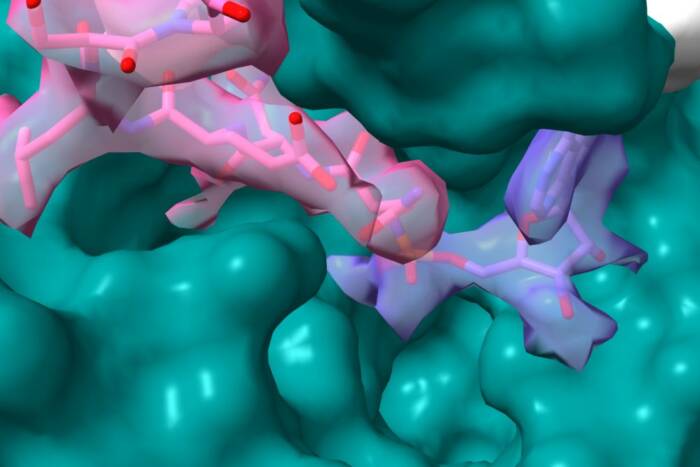Fat, Body Weight Regulated by Newly Discovered Hormone
Body Weight Regulated by Newly Discovered Hormone
A protein, identified in mice and humans, reduced body weight in mice by 30 percent after two weeks of treatment, report scientists in the July 28 Science. The findings have important implications for understanding the causes of obesity, which affects one in three Americans.

Both of these mice have a defect in a gene called obese (ob). This mutation usually results in a marked increase in the amount of fat. Administration of the protein encoded by the ob gene, called leptin, reduced the body weight of the ob mice. After four and a half weeks, the ob mouse on the left, which did not receive leptin, weighed approximately 67 grams while the mouse on the right, who received daily injections of leptin, weighed 35 grams. Normal mice weigh approximately 24 grams, a weight equivalent to that of an orange. Daily injections of leptin to ob mice reduced body weight via effects on food intake and energy expenditure, meaning the treated animals ate less and also burned more calories. Photo by John Sholtis, The Rockefeller University, New York, N.Y. Copyright ©1995 Amgen Inc.
New therapies for weight control in humans will require more studies and years of testing, the authors note. However, “the current results suggest the protein, leptin, is a novel hormone that regulates body weight by signaling the amount of fat stored,” explains senior author Jeffrey Friedman, M.D., Ph.D., professor at The Rockefeller University and an associate investigator with the Howard Hughes Medical Institute(opens in new window) (HHMI).
Friedman, collaborating with Stephen K. Burley, D.Phil., M.D., professor at Rockefeller and HHMI investigator, and several coinvestigators found the protein, named leptin from the Greek root leptosmeaning thin, in the blood of mice and humans. Man-made versions of mouse and human leptin decreased the body weight of mice by reducing food intake and increasing energy expenditure. The instructions to make leptin are carried by a gene that is defective in the obese (ob ) mouse. The obmouse was identified by scientists at the Jackson Laboratory in Bar Harbor, Me., in 1950. Friedman and his colleagues reported the cloning of the ob gene in December 1994.
“The pace at which these discoveries are being made is truly remarkable,” says Purnell W. Choppin, M.D., HHMI president. “The molecular approach to understanding obesity that Dr. Friedman and his colleagues have chosen has proven to be a wise one.”
Defects in the ob gene result in massive obesity in mice as part of a syndrome that resembles obesity in humans. “The new findings indicate that when ob is defective, leptin is not made and does not transmit its signal to stop eating,” says lead author Jeffrey L. Halaas, biomedical fellow at Rockefeller. Consequently, mice with a faulty ob gene are overweight and have a form of diabetes.
The scientists now are seeking to understand how leptin transmits its weight-reducing signal. Friedman notes the hypothalamus, the part of the brain that coordinates basic bodily functions such as food intake, is likely to receive leptin’s signal, either directly or indirectly.
Obesity, defined as being more than 20 percent over an ideal weight, is a major risk factor for diabetes, heart disease, high blood pressure, stroke, sleep apnea, gallstonesas well as some cancers and forms of arthritis. In the United States, more than one third of adults–50 million people–are obese, reports the National Institute of Diabetes and Digestive and Kidney Diseases (NIDDK), which with the U.S. Public Health Service supported the study. In the last 10 years, the number of overweight Americans has increased from 25 to 34 percent.
“While diet and exercise are presently the cornerstone of weight control, this new molecular approach to understanding the regulation of body weight is one of the best examples of real progress in biomedical research,” says Phillip Gorden, M.D., director of NIDDK, which is part of the National Institutes of Health.
The researchers measured the amounts of leptin in mouse blood and found that mice with a defective obgene do not make the hormone. Another kind of obese mouse, with a defective gene called diabetes (db), has levels 10 times greater than normal mice. The db mice are thought to have a defective leptin receptor. Receptors are specialized proteins that receive cellular signals. The investigators also found leptin in the blood of six lean humans.
In a four-week mouse study, the investigators gave sets of 10 ob, db and normal mice daily injections of mouse leptin, made in the laboratory by inserting the ob gene into bacteria. Each of the mice received 5 milligrams leptin per kilogram of body weight. For comparison, control mice received either injections of a salt solution or no treatment.
“The effect of the laboratory derived leptin on food intake and body weight in mice is dramatic,” says Burley.
After two weeks of treatment with leptin, the ob mice lost 30 percent of their body weight without side effects. The reduced weight in these mice also came exclusively from fat loss. For example, at the end of the study treated ob mice had 9.1 grams of fat while untreated ob mice had 38.30 grams of fat. A normal, healthy adult mouse has between 2 and 5 grams of fat.
In contrast, leptin had no effect on the db mice. “The failure of leptin to reduce body weight or food intake in db mice is consistent with earlier suggestions that these mutant mice are missing the leptin receptor and are thus resistant to the effects of the hormone,” says Friedman.
Normal mice receiving leptin lost about 12 percent of their weight and almost all of their body fat. The body fat content of the normal mice receiving leptin fell from 12.2 to 0.67 percent.
Leptin improved diabetes in the ob mice as evidenced by a decrease in the level of sugar in their blood. “It is not clear if this improvement in diabetes is solely a result of weight loss or if leptin has independent effects on the regulation of blood sugar,” says Friedman.
Leptin treatment not only reduced food consumption in the ob mice, but also increased their energy expenditure. Four days after starting leptin, the ob mice consumed about 60 percent less food compared to untreated ob mice. When the researchers put a group of untreated ob mice on a low calorie diet in which they were fed only as much food as eaten by the treated ob mice, the food-restricted mice lost less weight : 11 gram loss in dieting mice versus 16 gram loss in mice receiving leptin. This result suggests that the protein also increases energy expenditure, Friedman adds.
Mouse and human leptin both reduced body weight in ob mice. “The fact that human leptin reduces weight in the mice raises the possibility that giving leptin to people might have similar effects. However, we must proceed cautiously to prove that the protein treatment is safe in animals. Studies of humans cannot begin until the protein has been confirmed to be without unwanted side effects,” says Friedman.
Friedman, Halaas and Burley’s coauthors include: Ketan S. Gajiwala, Ph.D., Margherita Maffei, Ph.D., Steven L. Cohen, graduate fellow, and Brian T. Chait, D.Phil., of Rockefeller; Daniel Rabinowitz, Ph.D., of Columbia University in New York, N.Y.; and Roger L. Lallone, Ph.D., of Brookwood Biomedical in Birmingham, Ala. Gajiwala also has an appointment with HHMI.


